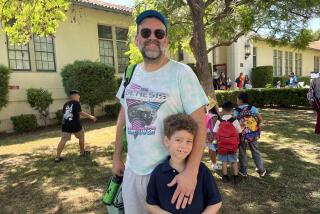Address Violence, Fear
- Share via
It’s an unsettling time to be a high school student or the parent of one. More than 1,500 students stayed home from El Camino Real High School on April 20 after rumors swirled that something would happen that day, the anniversary of the 1999 shooting rampage at Colorado’s Columbine High School.
Graffiti alluding to violence had been found earlier in the month on a school poster. The Woodland Hills school administrators took the graffiti seriously, as every school must these days. But an investigation, letters to and meetings with parents, stepped-up security and the reassurances of the principal and teachers could not calm the wave of hysteria sweeping the campus.
The students who stayed home may have even felt vindicated when, a few days later on the other side of the San Fernando Valley, two 18-year-olds were arrested and booked on suspicion of plotting to detonate a bomb at Burbank High School, where one was a student. The two pleaded not guilty. Police found no explosives but said they believed the threat to be credible.
Are our schools safe? According to Safe Communities, Safe Schools, a Colorado consortium founded after the Columbine massacre, the answer is yes. Only 1% of homicides involving school-age youth occur at schools. Both El Camino Real and Burbank high schools have reputations as particularly peaceful campuses, known for winning Academic Decathlon competitions, not for violence.
But fear does not always respond to reason, as shown by the more than 40% of El Camino Real’s 3,500 students who chose to stay home.
The Colorado Safe Schools group listed concrete steps schools can take to deal with and, more importantly, prevent violence. Some of the steps, such as preparing a crisis management plan, have already been taken by Los Angeles schools.
The group also recommends anti-bullying programs, which are particularly relevant in light of a study published last week in the American Medical Assn. Journal. Saying that bullies and their victims are more likely to have psychological or behavioral difficulties, the researchers recommend that bullying be treated not as a normal part of growing up but as a public health problem. Revenge for bullying has been cited as a motive in recent school shootings.
Bullying involves not just bullies and victims but a sizable number of others--other children, teenagers, even adults--who watch and do nothing. Doing something, taking concrete steps to change behavior and to prevent violence, is one way for students to feel that they have some control over their environment. It is one way to counteract fear, which largely involves feeling out of control.
The students’ absence cost El Camino Real at least $39,000 in state funding, which is based on a school’s daily attendance--enough to pay a teacher’s salary for a year.
It cost instruction time both on the day lost and on the hours spent readmitting students to school.
And worse, it rewarded intimidation--bullying, if you will--at the expense of confidence and morale.
“Don’t succumb to the unknown,” Principal Ron Bauer counseled students. At least 2,000 of them refused to turn April 20 into a macabre, undeserved school holiday.
More to Read
Sign up for Essential California
The most important California stories and recommendations in your inbox every morning.
You may occasionally receive promotional content from the Los Angeles Times.












